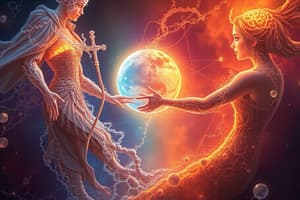Podcast
Questions and Answers
What happens to the temperature of a substance during a phase change?
What happens to the temperature of a substance during a phase change?
- It fluctuates randomly.
- It remains constant. (correct)
- It decreases steadily.
- It increases steadily.
Which property is primarily used in laboratories to determine the purity of a substance?
Which property is primarily used in laboratories to determine the purity of a substance?
- Melting point. (correct)
- Color.
- Boiling point.
- Density.
How are elements arranged in the periodic table?
How are elements arranged in the periodic table?
- By their phase.
- By their chemical symbols.
- By their size.
- By their atomic number. (correct)
What is the symbol used to represent Lead in the periodic table?
What is the symbol used to represent Lead in the periodic table?
Which statement correctly describes the location of metals and non-metals in the periodic table?
Which statement correctly describes the location of metals and non-metals in the periodic table?
What distinguishes a homogeneous mixture from a heterogeneous mixture?
What distinguishes a homogeneous mixture from a heterogeneous mixture?
Which method is most effective for separating components of a solution?
Which method is most effective for separating components of a solution?
Which of the following is NOT a type of pure substance?
Which of the following is NOT a type of pure substance?
What is a characteristic property of suspensions?
What is a characteristic property of suspensions?
Which statement about mixtures is true?
Which statement about mixtures is true?
What is the process called when a solid changes directly into a gas?
What is the process called when a solid changes directly into a gas?
Which state of matter has particles that are closely packed but can still move past one another?
Which state of matter has particles that are closely packed but can still move past one another?
What happens to energy during the process of freezing?
What happens to energy during the process of freezing?
During which phase transition does matter convert from a gas to a liquid?
During which phase transition does matter convert from a gas to a liquid?
Which of the following correctly describes the state of plasma?
Which of the following correctly describes the state of plasma?
What is the definition of matter?
What is the definition of matter?
Which statement accurately represents the Law of Conservation of Matter?
Which statement accurately represents the Law of Conservation of Matter?
What is demonstrated by the image of the person labeled 'Before' and 'After' weighing the same?
What is demonstrated by the image of the person labeled 'Before' and 'After' weighing the same?
What distinguishes matter from energy?
What distinguishes matter from energy?
Which of the following is true regarding chemical reactions?
Which of the following is true regarding chemical reactions?
Flashcards are hidden until you start studying
Study Notes
Phase Changes
- Matter changes phase when heated or cooled, but the temperature remains constant during the phase change.
- The temperature at which a substance changes phase is a critical property for identification and purity determination.
- The melting point is used to assess the purity of substances.
Chemical Symbols
- Elements are represented by symbols.
- Symbols are derived from the Latin name of the element and typically consist of one or two letters.
- Lead, for example, is represented by the symbol Pb (derived from the Latin word "plumbum").
The Periodic Table
- The periodic table organizes elements based on their atomic number.
- Metals are located on the left side of the periodic table, while non-metals are positioned on the right.
- The border between metals and non-metals is occupied by semi-metals (metalloids).
Types of Matter
- Matter is classified into two primary categories: pure substances and mixtures.
- Pure substances encompass elements and compounds.
- Mixtures consist of two or more pure substances.
Types of Mixtures
- Homogeneous mixtures, also known as solutions, have a uniform composition throughout.
- Heterogeneous mixtures, which include suspensions and mechanical mixtures, exhibit non-uniform composition.
Separation Techniques
- Different techniques are used to separate mixtures based on their properties.
- Suspensions tend to separate naturally unless an emulsifier is present, as seen in the separation of oil and water.
- Distillation is a technique utilized to separate solutions based on the disparity in boiling points of the components.
Summary Diagram of Matter
- Matter can be categorized into:
- Pure Substance
- Element
- Compound
- Mixture
- Homogeneous Mixture
- Heterogeneous Mixture
- Pure Substance
Visual Representation
- Elements and compounds have distinct molecular arrangements, reflecting their composition and mixture types.
What is Matter?
- Matter is defined as anything that possesses mass and volume.
- All objects, except for energy, are considered matter.
Matter is Conserved
- The Law of Conservation of Matter states that matter cannot be created or destroyed during a chemical reaction.
- In chemical reactions, atoms rearrange, but the total mass of the reactants and products remains constant.
Illustration
- In chemical changes, mass is conserved. No matter the scale of the reaction, mass is neither gained nor lost.
States of Matter
- Matter exists in three common states:
- Solid: particles are rigidly arranged in a regular pattern, vibrating in place.
- Liquid: particles are free to move around, but not beyond each other.
- Gas: particles can move freely in any direction.
- All matter can transition between these states by adding or removing energy.
- Plasma, a fourth state of matter, is a highly ionized gas composed of charged particles.
Phase Changes
- Matter can transition between the four common phases by adding or removing energy, a process called phase change.
- Each phase change is uniquely named, depending on whether energy is added or removed.
Energy Transfer Diagram
-
Solid to Liquid: Melting
-
Liquid to Gas: Vaporization
-
Gas to Liquid: Condensation
-
Liquid to Solid: Freezing
-
Solid to Gas: Sublimation
-
Gas to Solid: Deposition
-
Gas to Plasma: Ionization
-
Plasma to Gas: Deionization
-
Diagrams illustrating the relationships between different states and phase changes can help visualize these processes.
Studying That Suits You
Use AI to generate personalized quizzes and flashcards to suit your learning preferences.




